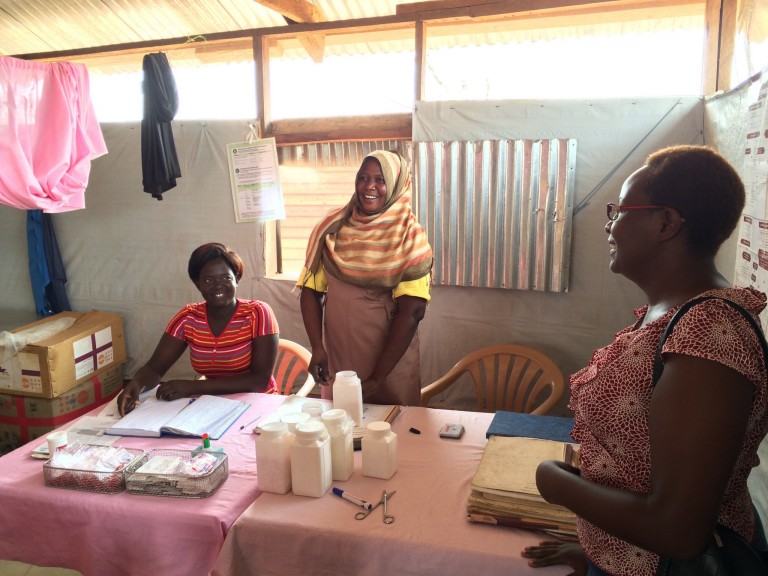By Elaine Scudder, senior manager of Newborn Health, Save the Children; Kate Kerber, senior technical specialist, Save the Children; Grace Njiru, International Medical Corps (IMC) midwife in South Sudan.
As humanitarian crises worsen around the world, the role midwives play to save women and babies is increasingly important. A new training program and Field Guide will help support their work.
“I woke up to sounds of gunshot, at first I thought I was dreaming but the reality dawned on me when the gun shots could be heard at close range. I looked out of my tukul (mud and thatch hut) and women and children were running, some carrying a few belongings on their heads. I did not know what to do; my legs were numb, I could not move. After an hour of shooting, women screaming and children crying, the air was still. The dogs stopped barking. Shortly after I was called to the clinic to attend to a woman who had been overwhelmed by labor pains and sought refuge in our maternity unit. I was concerned about my safety and not sure if I should go out to the clinic to deliver the woman, but at that moment I realized that was exactly the reason I was here in South Sudan – to help women during such times. She had a safe delivery and a healthy baby boy. The woman said she was glad to have come to the clinic since otherwise she would have delivered in the bush with no one to attend to her.”
– Grace Njiru, IMC midwife in South Sudan
In 2016, the number of people worldwide that are estimated to need humanitarian aid is a staggering 125.3 million. Of that, the United Nations Office for the Coordination of Humanitarian Affairs (OCHA) global humanitarian response will deliver aid to 87.6 million people across 37 countries.
Conflict and disaster create long-term public health impact and result in significant mortality. Health service delivery challenges in complex emergencies are aggravated by deterioration in facility infrastructure, supply chain for medical supplies and drugs, and health worker shortages. Pregnant and newly delivered women and their newborns are particularly vulnerable. In times of crisis, mothers must overcome immense obstacles to provide care and safety for their children, and particularly newborns, even while their own vulnerability to poverty, malnutrition, sexual violence, unplanned pregnancy, and unassisted childbirth greatly increases.

On May 5 we celebrate the International Day of the Midwife. Midwives are essential health service personnel, and nowhere is this more evident than in humanitarian emergency settings. Local health workers, including midwives, face threats to their own health and security, families, and homes, and take risks to continue their work. Data from Liberia during the peak of the Ebola outbreak demonstrate the likely scenario in most emergencies – the health system falters, even for routine, essential services during pregnancy and delivery, under excess patients and overburdened staff.
To help address these critical needs, an inter-agency collaboration between UNHCR, UNFPA, UNICEF, WHO, CDC, IRC, Save the Children, World Vision International, IMC, MSF, and Women’s Refugee Commission developed the Newborn Health in Humanitarian Settings: Field Guide. The Field Guide is a companion to the Inter-Agency Field Manual on Reproductive Health in Humanitarian Settings, and is a compilation and summary of existing WHO standards of care for newborn health with additional guidance on how to provide newborn services in the context of a humanitarian setting. It aligns with the Abu Dhabi Declaration, which urges the global community to ensure that processes, funding, and coordination are mainstreamed across the development and humanitarian continuum and include a strong focus on risk preparedness and community resilience.
The Field Guide prioritizes the most critical health services and supplies to prevent and manage the three main causes of newborn death – prematurity, severe infections and intrapartum-related complications – at each level of care. Additionally, tools are included for staff involved in designing, managing, and monitoring and evaluating newborn health services in humanitarian settings. A short training curriculum for newborn care is being developed and costed for health workers, aimed at midwives. The training is complemented by newborn care supply kits – pre-packaged kits containing critical medicines, drugs, and supplies midwives need to address the health needs of newborns.
Midwives are resilient, and in crisis settings, they are reliable, trusted, and accessible sources of care for populations most in need. By using a short training program that maximizes the capacity and time of both skilled and traditional attendants, vulnerable populations can ensure they have access to high quality care, based on international guidelines, during a critical time of need. We hope the Field Guide, training package, and supply kits will make their work a little bit easier in the world’s most challenging settings.
Through ICM, Save the Children has honoured midwives providing excellence in midwifery care since 2005.
